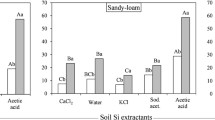Summary
The data presented throughout this paper indicate that soluble Si in plant tissues can give useful information about the Si-status of plants. In fact, this fraction of plant Si seems to be less subject to extraneous variation than does total Si. Silicon which can be extracted with dilute TCA is a discrete fraction. The amount extracted was little influenced by extraction time, amount of extractant, or number of extractions. The soluble-Si fraction was not stable before extraction. Concentration decreased with time. The rate of decrease was temperature related. Storage in a nitrogen atmosphere decreased Siimmobilization.
Total and soluble Si were higher in sugar cane leaf sheaths than leaf blades. Total Si was much higher in leaf sheaths and blades than in the internodal tissue. Soluble Si was highest in the least mature tissues; whereas total Si was highest in the recently mature tissue. Once a cane leaf is mature, there seems to be little change in total Si with time. Evidently Si-deposition in sugar cane is associated with growth.
Total Si of leaf blades was more responsive to slag applications than was total Si of leaf sheaths. The reverse was true for soluble Si. The mature stalk tended to be the most responsive tissue in relative terms.
Both soluble and total Si reflect differences in soil and irrigation water Si. Total Si in the plant was apparently depressed by stress associated with ripening. When silica deposition was depressed, soluble silicon accumulated in the tissue if there was adequate available Si in the soil.
Similar content being viewed by others
References
Ayres, A. S., Calcium silicate slag as a growth stimulant for sugar cane on low-silicon soils. Soil Sci.101, 216–227 (1966).
Baker, G., Opal phytoliths in Victoria soils. Australian J. Botany7, 64–87 (1959).
Clements, H. F., Foundations for objectivity in tissue diagnosis as a guide to crop control. Plant Anal. Fertil. Prob.4, 90–110 (1964).
Clements, H. F., Effects of silicate on the growth and leaf freckle of sugar cane in Hawaii. Proc. Intern. Soc. Sugar cane Tech. 12th Congr., Puerto Rico 197–215 (1965).
Clements, H. F., The roles of calcium silicate slags in sugar cane growth. Rep. Hawaii Sugar Tech. pp. 103–126 (1965).
Comhaire, M., The role of silica for plants. Agri Digest No.7, 9–19 (1966).
Fox, R. L., J. A. Silve, O. R. Younge, D. L. Plucknett, and G. D. Sherman, Soil and plant silicon ond silicate response by sugar cane. Soil Sci. Soc. Amer. Proc.31, 775–779 (1967).
Jones, L. H. P. and Milne, A. A., Studies of silica in the oat plant. II Distribution of the silica in the plant. Plant and Soil18, 358–371 (1963).
Jones, L. H. P., A. A. Milne, and Wadham, E. M., Study of silica in the oat plant. I. Chemical and physical properties of the silica. Plant and Soil18, 207–220 (1963).
Jones, R. L. and Beavers, A. H., Some minerological and chemical properties of plant opal. Soil. Sci96, 375–379 (1963).
Lanning, F. V., Ponnaiya, B. W. X., and Crumpton, C. F., The chemical nature of silica in plants. Plant Physiol.33, 339–343 (1958).
Lervin, J. C., The dissolution of silica from diatom walls. Geochim. Cosmockim. Acta21, 182–198 (1960).
Lovering, T. S., Significance of accumulator plants in rock weathering. Bull. Geol. Soc. Am.70, 781–800 (1959).
Okuda, A. and Takahashi, E., The role of silicon,In Symposium on the Mineral Nutrition of the Rice Plant. International Rice Research Institute. Los Banos, Philippines (1964).
Plucknett, D. L. and Fox., R. L., Effects of phosphorus fertilization on yields and composition of pangolagrass andDesmodium intortum. Proc. 9th. Int. Grassland Congr. Sao Paulo, Brazil, 1525–1529 (1966).
Siever, R. Silica solubility, 0°–200°C and the diagnosis of siliceous sediments, J. Geol.70, 127–150 (1962).
Tanaka, A. and Park, Y. D., Significance of the absorption and distribution of silica in the growth of the rice plant. Soil Sci. and Plant Nutr.12, 191–196 (1966).
Yoshida, S., Ohnishi, Y., and Kitagishi, K., Chemical forms, mobility and deposition of silicon in rice plant. Soil Sci. and Plant Nutr.8, 107–113 (1962).
Younge, O. R. and Plucknett, D. L., Quenching the high phosphorus fixation of Hawaiian Latosols. Soil Scil Soc. Am. Proc.30, 653–655 (1966).
Author information
Authors and Affiliations
Additional information
Published with the approval of the Director of the Hawaii Agricultural Experiment Station as HAES Tech. Paper No.893. The work was done in cooperation with the Division of Agricultural Development, Tennessee Valley Authority.
Rights and permissions
About this article
Cite this article
Fox, R.L., Silva, J.A., Plucknett, D.L. et al. Soluble and total silicon in sugar cane. Plant Soil 30, 81–92 (1969). https://doi.org/10.1007/BF01885263
Received:
Issue Date:
DOI: https://doi.org/10.1007/BF01885263



